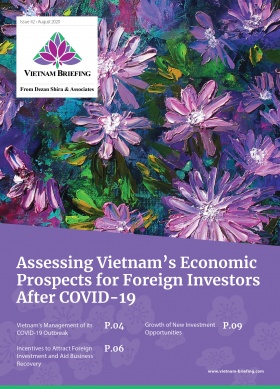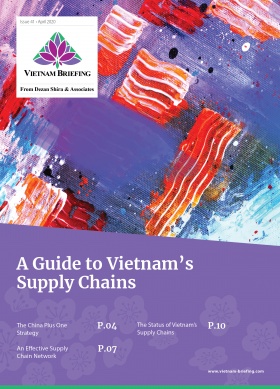Q&A: Food and Beverage in EVFTA: How Can Foreign Investors Qualify For Preferential Tariffs
At an average growth rate of approximately 7 percent, the food and beverage (F&B) industry is one of the fastest-growing sectors contributing to 15 percent of Vietnam’s GDP in 2019.
As a result, in the last few years, numerous foreign businesses have invested significantly in this market, with Korean and Japanese investors leading and seizing this opportunity. The trend is set to continue with more investors from other regions around the world, including the EU, looking to enter this developing market.
With the EU-Vietnam FTA (EVFTA) in effect, the F&B market is expected to open even further to EU businesses bringing in new investment inflow for the foreseeable future.
To learn more about the benefits of the EVFTA on the F&B industry, our Business Intelligence Assistant Manager – German Desk, Do Thanh Huyen, conducted a webinar on how investors can qualify for preferential tariffs for the F&B industry. During this webinar, Huyen discussed Vietnam’s F&B industry potential, including emerging opportunities and challenges, and finally ideal market entry options for foreign investors. The webinar can be viewed here.
We highlight some insights below:
What does Vietnam’s F&B industry look like today?
Vietnam’s F&B industry is quite promising and represents significant opportunities for EU investors. The county’s middle class is expected to reach 33 million by the end of 2020 contributing to significant growth due to disposable incomes. This population is also increasingly conscious of their dietary needs and wants to avoid negative impacts to their health.
There are currently more than 9000 food manufacturing companies in Vietnam, which are dominated by businesses of less than 50 employees. Vietnam is a net exporter of food, however, imports are growing faster than exports. A typical monthly household consumption expenditure per capita is around US$111. Pork is an extremely important product in the Vietnamese diet; its capita consumption is expected to increase by 20 percent until 2027.
Can you identify some trends in the F&B industry in Vietnam?
With several Vietnamese coming back to the country, we have seen an increase in supermarkets by both domestic and foreign investors. There has also been an increased focus on healthy food. With that being said however, there has been an increase in popular fast food chains. An increase of food delivery apps have also made it easier to order a wide and diverse choice of foods.
What are some major imported products from the EU?
The top five export products from the EU to Vietnam are mainly meats (16 percent), beverages (9 percent), dairy products (7 percent), fish, and products such as flour, starch, and pastry products.
Millennials are the largest consumer group in Vietnam and consumers buying such imported products come from urban areas with higher social classes compared to rural consumers who comprise the majority of the population.
What are some common F&B retail channels?
Traditional F&B retail outlets such as small shops and wet markets dominate the F&B landscape. These tend to be smaller, are flexible in dealing with customers, and are typically close to residential areas. However, concerns remain regarding hygiene infrastructure.
Modern F&B outlets such as hypermarkets and supermarkets are increasing, particularly in urban areas. These types of markets also have faster growth rates than traditional F&B shops.
Other common retail channels are F&B service outlets. These consist of restaurants, and coffee shops. This category has grown at twice the rate of GDP in recent years driven by socio-economic changes and tourism.
And lastly are e-commerce channels. COVID-19 has provided opportunities for e-commerce retail. With an estimated 70 percent of Vietnam’s population having access to the internet, key players in this category are Tiki, Sendo, Lazada, and Shopee
What are some emerging opportunities with the EVFTA in effect?
Vietnam considers the EU as a single entity and is thus committed to international standards when drafting regulations. While it is currently challenging for EU companies to enter the Vietnamese market, several tariffs will be phased out in the coming years. The EVFTA is expected to boost EU exports to Vietnam for products such as cheese, ham, and liquor. For some seafood products, the tariffs were immediately removed as the FTA took effect.
In addition, around 169 Geographical Indications (GIs) such as alcohol and cheese are protected from imitation in the Vietnamese market thus benefitting EU farmers and small businesses.
Can you tell us about some of the trade barriers?
Some trade barriers remain due to strict food safety legislation and several certifications for food imports into Vietnam. Vietnamese food safety standards are strict due to several scams. All imported food products are subject to safety clearances except for some specific products. These can thus result in lengthy import procedures, particularly for fruits and vegetables, such as kiwi and grapes.
Vietnam subjects food products to three categories of inspection such as strict, generic, and simplified inspections. Roughly, 30 percent of technical regulations are dedicated to food products.
Vietnam is also involved in four disputes with the World Trade Organization (WTO) regarding trade. Vietnam doesn’t allow imports from countries that have had mad cow disease.
Vietnam has also placed some restrictions on the exports of beef and market access has been granted to some EU members such as France, Spain, Belgium, and the Netherlands, though exports of some cuts of beef from these countries can still face challenges.
What are some market entry strategies to enter the Vietnamese market?
Investors can participate in trade shows and trade missions which are good opportunities to explore the market and enter into partnerships with a local partner. The second option would be to establish a representative office to explore the market for Vietnamese consumers. At the high-level investors could also establish a trading company to import products and distribute them in Vietnam. However, importing and exporting requires several licenses, which can take time.
In our opinion, investors should conduct a business matching project to identify reliable partners for entering the Vietnamese market. A business matching project involves criteria clarification, long list development, shortlisting, outreach, and meetings.
Investors can also source directly, however consulting services are more valuable and can guide investors through their partnerships with business chambers, trade organizations, and local contacts.
Can you tell us about some of the general requirements for F&B products exports to Vietnam?
Exporters need to prepare a commercial invoice, a packing list, certificate of non-preferential origin, proof of preferential origin, and certificate of free sale.
Please be advised that this is just a general requirement; depending on the product in question there could be further specific requirements such as the certificate of analysis, certificate of good manufacture practice, and phytosanitary certificates which are applicable to meats, baby food, and fruits and vegetables.
Exporters are advised to check all requirements carefully so that their products are not rejected by customs. In addition, they should also pay close attention to rules of origin guidelines to qualify for the preferential tariffs.
About Us
Vietnam Briefing is produced by Dezan Shira & Associates. The firm assists foreign investors throughout Asia from offices across the world, including in Hanoi and Ho Chi Minh City. Readers may write to vietnam@dezshira.com for more support on doing business in Vietnam.
- Previous Article FDI-Daten zeigen Vietnams stetiges Wirtschaftswachstum
- Next Article EVFTA: Vietnams Dekret 111 – Details zur präferenziellen Export- und Importzollstruktur






